Modular Strategy and Potential
The decision to move forward with modularity comes from aligning strategy with a business case that scrutinizes the costs, benefits, risks and timing. Modular Strategy and Potential (MSAP™) defines a market-driven modular strategy, sets targets and calculates the financial potential of implementing modular design and determines the expected return on investment. With this business case in hand you can set the strategic direction for your company.
Explore Your Potential
The decision to go forward with modularity comes by aligning strategy and making a business case that scrutinizes the costs, benefits, risks and timing.
Modular Strategy and Potential™ (MSAP) defines a market-driven modular strategy, sets targets and calculates the financial potential of implementing modular design, plans the implementation program, and determines the expected return on investment.
Modularity is a transformative business improvement process that impacts all of the functions of your organization. It will cause you to rethink the way you approach your supply chain, production lines, marketing, IT systems, organization, and decision criteria for cost and profitability.
In conducting your Modular Strategy, Modular Management engages resources from across your organization to explore the potential of modularity. We lead management workshops to share our key findings, gain alignment on the strategy, agree on the results, and formulate a way forward. Setting your Modular Strategy takes from eight to sixteen weeks depending upon the breadth and scope of analysis and the resource availability.
The Modular strategy and Potential Analysis is a five-step process:
1. Establish Baseline
2. Clarify Strategy and Objectives
3. Establish Targets
4. Quantify Benefits
5. Plan Path

1. Establish Baseline
The first step in the analysis is to establish the baseline of the business and identify the current sources and impacts of operational and product structure complexity. The analysis begins by collecting data, including financial performance, process maps such as Order-to-Delivery and Product Development, organizational structure and roles as well as the current IT infrastructure.
In addition to collecting data, we interview stakeholders across key functions at multiple levels to understand the current state, guiding principles, activities and costs. We also conduct workshops to understand the existing product architecture and market opportunity. The findings are analyzed to determine the baseline for the benefits of modularity. Some gaps will suggest an approach for further study to identify what is needed to fully transform the company and capitalize on all the benefits.
2. Clarify Strategy and Objectives
Strategy sets the course for how your company will realize its vision and mission as it competes in its chosen markets with products produced by its resources. Objectives should guide the functions of your company to achieve this strategy.
Modular Management characterizes strategy within a three dimensional framework defined by Operational Excellence, Product Leadership, and Customer Intimacy. We take a holistic view of your operational, product, market and financial situation, and, together, we decide how modularity can best support and fulfill your strategic objectives.
These decisions drive the modular design of your product families to achieve strategic objectives, focusing on all three dimensions simultaneously. This will establish the product foundation to drive increases in sales, profitability and ultimately sustainable value creation.
3. Establish Targets
The benefits of modularity come from both eliminating the costs driven by non-value added complexity and by capitalizing on the opportunities resulting from a less complex operation and more flexible product architecture.
A key element of the MSAP is estimating the Cost of Complexity. This concept is widely known and accepted, but its quantification and application in making business decisions are not broadly understood. Modular Management applies our methodology and extensive experience to examine your total costs: labor, materials, capital, SG&A, etc. We identify the proportion of those costs that are driven by the existing product architectures. Product families based upon modular design are inherently less complex so the benefit is proportional to the difference between the two.
4. Quantify Benefits
Modularity also yields top-line benefits. The MSAP explores opportunities for revenue growth with faster time to market, reduced lead times and a broader range of differentiated products offered to the market.
We will work with you to set leading targets to achieve the right level of complexity and capitalize on the available market opportunities. These targets will drive your modularization program and calibrate the financial potential of modularity. Together with your team we will plan the program and identify the required resources.
5. Plan Path
The MSAP analysis of your company’s potential with modularity and the corresponding benefits is only the first step. Beyond Formulate, a full modularity program includes the phases of Create, Implement and Govern.

TECHNOLOGY
PALMA®
This is the world-class solution for product management.
Standing for Product Assortment Lifecycle Management, PALMA is cloud-based strategic software for how to create, document and govern modular product architectures. With this unique structured approach and strategic software you can design, document and configure products. You can also connect enterprise systems and secure business goals.
Built on an in-memory database platform, PALMA is faster and more capable than anything else on the market, so you can create configuration rules without coding, govern product architecture life cycles and create a business advantage.

